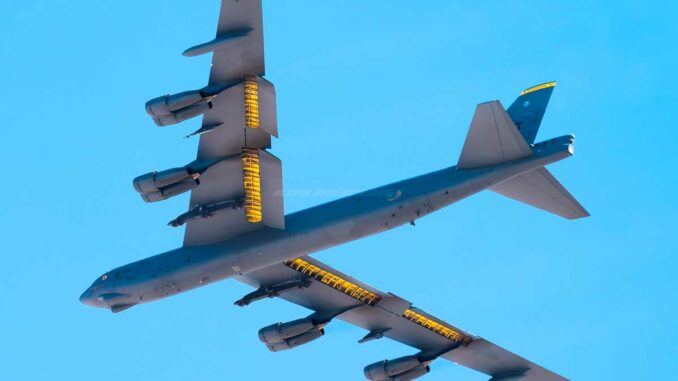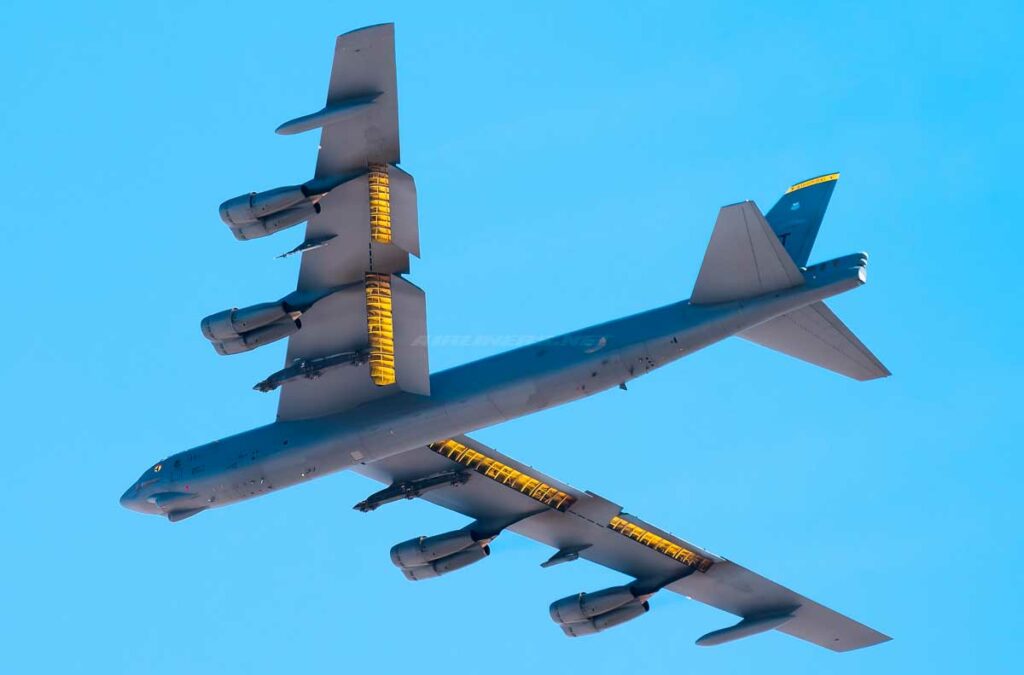
Three US B-52s approach Caracas; Maduro scrambles F-16s. A strategic patrol that signals US resolve in the face of regional unrest.
Summary
On October 15, 2025, three US Air Force B-52H bombers took off from Barksdale Air Force Base (Louisiana) to fly over the Caribbean in extended orbit near Venezuelan airspace, coming within 160 km of Caracas. The Venezuelan government immediately responded by activating F-16 fighter jets to monitor the American aircraft. This move comes amid heightened tensions over alleged electoral interference, migration flows, and US military anti-trafficking operations in the Caribbean. While officially presented as a deterrence and strategic posture mission, the operation sends a clear signal to Caracas that the US is asserting its ability to project power. This move is part of a hemispheric military dynamic marked by intensified US naval and air deployments around Venezuela, and reignites the debate on the limits of the legitimacy of such demonstrations in an unstable region.
The mission: flight path and airspace context
The three B-52s were spotted on Flightradar24 with the call signs BUNNY01, BUNNY02, and BUNNY03. They followed a trajectory from Louisiana via the Gulf of Mexico, crossed the Yucatán Channel, and then flew in the Maiquetía Flight Information Region (FIR), managed by Venezuela, just a few hundred kilometers from Caracas. The aircraft remained in orbit for nearly two hours without entering national airspace. This maneuver is similar to other Bomber Task Force missions carried out by the Air Force to demonstrate its strategic reach. According to observers, this flight was not a combat mission, but a visible neutrality operation, testing endurance, in-flight refueling, and cross-domain coordination. The use of KC-135 tankers is almost certain, given the distance traveled. The B-52H model is still used for its ability to carry heavy conventional or nuclear loads and its proven reliability, even in the modern era.
Venezuela’s response: mobilization and defensive posture
Following the overflight, President Nicolás Maduro ordered F-16s stationed at El Libertador military airport to scramble to intercept or directly monitor the B-52s. Although no confrontation was reported, this response reflects a desire to defend air sovereignty and prevent uncontrolled intrusion. Venezuela has described the US maneuver as a blatant provocation, denouncing it as military intimidation. The Venezuelan Ministry of Foreign Affairs has instructed its diplomatic representatives to lodge a complaint on the international stage, claiming that these flights violate the principles of air law. Furthermore, Caracas has mobilized ground forces and stepped up surveillance of its coastline, fearing that this demonstration could be a prelude to more daring actions. The message conveyed is twofold: fierce defense of sovereignty and warning about the political cost of escalation.
Strategic objectives: deterrence, posture, and message
Beyond simple provocation, this mission serves multidimensional objectives. First, it is a tangible deterrent: demonstrating that the United States has rapid projection capabilities in its hemispheric “backyard.” Second, it is a strategic posture: placing B-52s in a highly visible space to signal to regional allies and adversaries that Washington is closely monitoring the area. Third, it reinforces the legitimacy of U.S. actions against illicit trafficking: by increasing its military presence, the U.S. administration can justify its naval strikes or interceptions of suspicious vessels. Finally, it has a psychological effect on Caracas: forcing the regime to treat each incident as a crisis, thereby diverting its resources and internal attention. Combining visibility, strategic reach, and a clear message, this operation is a sophisticated use of hard power.
Legal framework and sovereignty issues
The United States operates in international airspace, where it claims the right to navigate freely. As long as the B-52s do not cross the Venezuelan air border, international law recognizes this type of flight. However, proximity raises legal debates: how close can a power get before it is perceived as an impermissible threat? Venezuela invokes the principle of non-interference and accuses Washington of geopolitical manipulation. For its part, the United States relies on aviation conventions and the doctrine of freedom of overflight. In a tense context, every kilometer flown close to national airspace becomes an act of political pressure. The line between a show of force and illegitimate intimidation is subtle.
The regional environment: tensions, deployments, and rhetoric
This mission is taking place in an already tense climate of rivalry. Upstream, the United States has stepped up its anti-trafficking naval operations: since September 2025, at least five US strikes have targeted vessels suspected of Venezuelan trafficking, causing around 30 deaths, according to Washington. The Department of Defense sees these actions as part of the fight against narco-terrorist cartels. At the same time, the Pentagon is deploying ships (destroyers, amphibious vessels) in the Caribbean and stepping up cooperation with bases in Latin America to strengthen maritime surveillance. For Caracas, these combined actions are part of a strategy of systematic pressure. Neighboring nations are divided: some welcome the US initiative to combat drugs, while others condemn the military escalation on their borders.

Technological and military capabilities of the B-52 today
The B-52H remains a workhorse despite its origins in the 1950s. It is equipped with modern avionics, sophisticated navigation capabilities, guided weapons, and electronic warfare systems. Its payload capacity is up to 32,000 kg (70,000 pounds), which can be used for cruise missiles, laser-guided bombs, or multi-role munitions. Its endurance is virtually unlimited thanks to in-flight refueling. The decision to use it in this area demonstrates the confidence that the United States continues to have in this aircraft for strategic “show-of-force” missions. In addition, the vehicle acts as an onboard command platform for multi-domain operations.
Possible escalation scenarios
Even without direct contact, the presence of B-52s creates risks. A miscalculation, an accidental incursion, or a flight perceived as hostile could trigger a Venezuelan response with surface-to-air missiles or close interception. If Caracas decides to further militarize its coastline or call on outside allies, the scale of the conflict could grow. Another scenario could involve the use of drones or asymmetric missiles to test the US response. Finally, a permanent reinforcement of the presence at sea or in the air could transform the theater into an area of continuous confrontation.
Diplomatic discourse and the battle of narratives
Washington presents this mission as an act of support for international norms and the fight against illicit trafficking. In the US media, the emphasis is on the threat it poses to US security—migration flows, drug trafficking, and foreign interference. Caracas, on the other hand, denounces interventionism. The contrast in narratives is stark: for one, it is a legitimate show of force; for the other, it is a disguised aggression. The rhetorical confrontation is just as crucial as the physical presence of the aircraft.
Outlook and future challenges
This B-52 mission may remain an isolated incident, but its repetition would strengthen the US posture in the region. If Washington makes these patrols routine, Caracas will be in a constant state of defense. The possibility of escalation is all the greater given that an external event—a maritime incident, a political assassination attempt, or third-party intervention—could catalyze a wider crisis. The challenge for Latin American neighbors will be to reconcile sovereignty with regional stability, while navigating between US pressure and local nationalism. Finally, for the United States, military investment in this area could become a lever for negotiation or influence in a Latin America undergoing geopolitical restructuring.
This aerial maneuver is not limited to a demonstration flight: it embodies a diplomatic and strategic instrument. The United States is reminding everyone that its power remains operational in the immediate vicinity of Caracas. The message is clear: the Caribbean sky is under observation, but also under potential threat—should the situation require it.
War Wings Daily is an independant magazine.